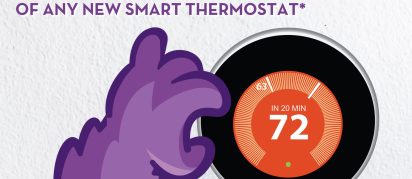Saving Money on Your Air Conditioning This Summer

According to Energy Star 1, your home heating and air conditioning system may account for up to 42% of your monthly utility bill. For those living in states with hot and humid climates, that number can easily reach 50% each month. With that much of your money going towards keeping you cool, it makes sense to have your air conditioning system running as efficiently as possible. Luckily, there are lots of tricks to bring down your bill that require very little effort.
When it comes to saving money, don’t forget that “nothing is cheaper than off”. If you’re a/c is not running, it is not costing you money. Some people say that turning the a/c off when you’re out of the house saves the most money. Others say it’s cheaper to leave it on, but raise the temperature a few degrees. Both sides present facts and data to prove their points, but in the end who is really right?
In actuality, there are just too many variables like attic insulation quality, window efficiency, and building leakage to make a definitive statement either way. The decision to turn-off or leave-on will more likely be determined by your personal comfort and not just on cost. Homeowners have to balance their tolerance for coming home to a hot and humid house and how long it takes for the house to cool down versus trying to save the most money. If your house is 100°F when you get home and it takes 2 hours to cool down to 73°F, is money that much of an issue when you’re sweating inside for 2 hours? Probably not. But if the house is 85°F and cools down to 73°F in thirty minutes, then perhaps it makes comfort-sense and financial-sense to leave the a/c off during the day. There isn’t a one-size-fits-all answer because every house is different and every person has a different comfort threshold.
Thankfully, homeowners have new technologies on their side to make the decision easier. By installing a programmable or a smart thermostat, homeowners can “set it and forget it.” With a programmable thermostat you can schedule the a/c to turn off just after you leave for the day. An hour or so before you return home, the system will turn the air back on and you’ll arrive to a cool and comfortable house. With a preset schedule the a/c can be off all day, but yet always comfortable when you’re home. Taking it to the next level, a newer “smart” thermostat can be controlled remotely by an app on your phone. If you decide to come home for lunch, use the app to turn on the a/c before you leave the office and you’ll eat lunch in a cool and comfortable home. Click the app again as you walk out the door and the a/c goes back to the normal schedule. There’s no reason why you can’t be comfortable and save money at the same time.
Using whatever thermostat you have, consider raising the room temperature a few degrees especially at night when you’re asleep. The EPA recommends 2 keeping the indoor temperature at around 78F, but many, many people set their thermostat to 70°F or even colder and pay big monthly bills as a result. If 78F feels too warm then set the thermostat as high as you can, but still feel comfortable. It may take a few days to get used to the warmer indoor temperature, but the long-term savings could be significant.
Along with raising the indoor temperature, ceiling fans circulate room air providing a cooling effect from the air movement. Fans make you feel cooler by blowing air across your body and providing a “wind chill” effect on your skin. A higher thermostat set point coupled with ceiling fans will make you feel much cooler than what the temperature set point actually is and can save you up to 14% on your electric bill.
Anything you can do to lessen the amount of heat inside the house will make it easier for your a/c unit to keep things cool. On bright, sunny days, close the blinds and curtains throughout the house or at least in unoccupied rooms. Sunlight beaming in through windows, especially inefficient single-pane glass, lets in a tremendous amount of solar heat making rooms much hotter. Closing the blinds blocks the incoming solar heat, keeps rooms cooler, and that takes some of the work off the a/c unit.
If you don’t need lights on, turn them off. If you still have incandescent or CFL bulbs, each one is pumping out heat and warming up the room. Try to get by without some of the lights on and you’ll not only save money on lighting costs, but you’ll reduce the room’s cooling load, too.
Just like your car, your a/c system needs regular maintenance. You wouldn’t buy a car and never change the oil or replace the battery. Sadly, most homeowners never invest in keeping their a/c working efficiently each season. Many just wait for it to break. Your a/c may be working, but it may be working so inefficiently that it costs a ton of money each month. Preventative maintenance addresses problems before the unit goes down. Ask yourself, do you know when the filter was last changed? Is there enough refrigerant in the system to cool your house properly? Are the condenser coils clogged? Having a summer service inspection can get your unit ready for the heat and ready to perform at its most efficient level for many years to come.
If you want to invest in your home for the long-term, improving the insulation value in the attic or upgrading the a/c system to a newer and more efficient model can make a tremendous positive impact on your utility bill. Not sure how efficient your windows or attic insulation is? Contact a reputable and licensed builder for a home inspection and energy audit. An energy audit will reveal where heat is getting in during the summer and where heat is escaping during the winter. The auditor can make recommendations and show you the install cost and energy savings to see if major upgrades make sense. They may suggest replacing old windows with double paned, insulated windows. Perhaps the attic needs another layer of insulation to keep the heating or cooling inside the house. Working with an air conditioning contractor, get options on upgrading the heating and air equipment to take advantage of today’s higher efficiency units that are 30% or even more efficient than older units.
The cost to keep your home cool is a big part of your monthly electric bill. Any way to reduce the run time of the air conditioning unit by using better thermostats, raising the room temperature, or reducing the building heat load will save you money. Luckily, homeowners don’t have to sacrifice comfort for energy savings. New technology lets you turn on the a/c only when you’re home and new high efficiency units with regular maintenance contracts keep a/c system running longer and more efficiently.



